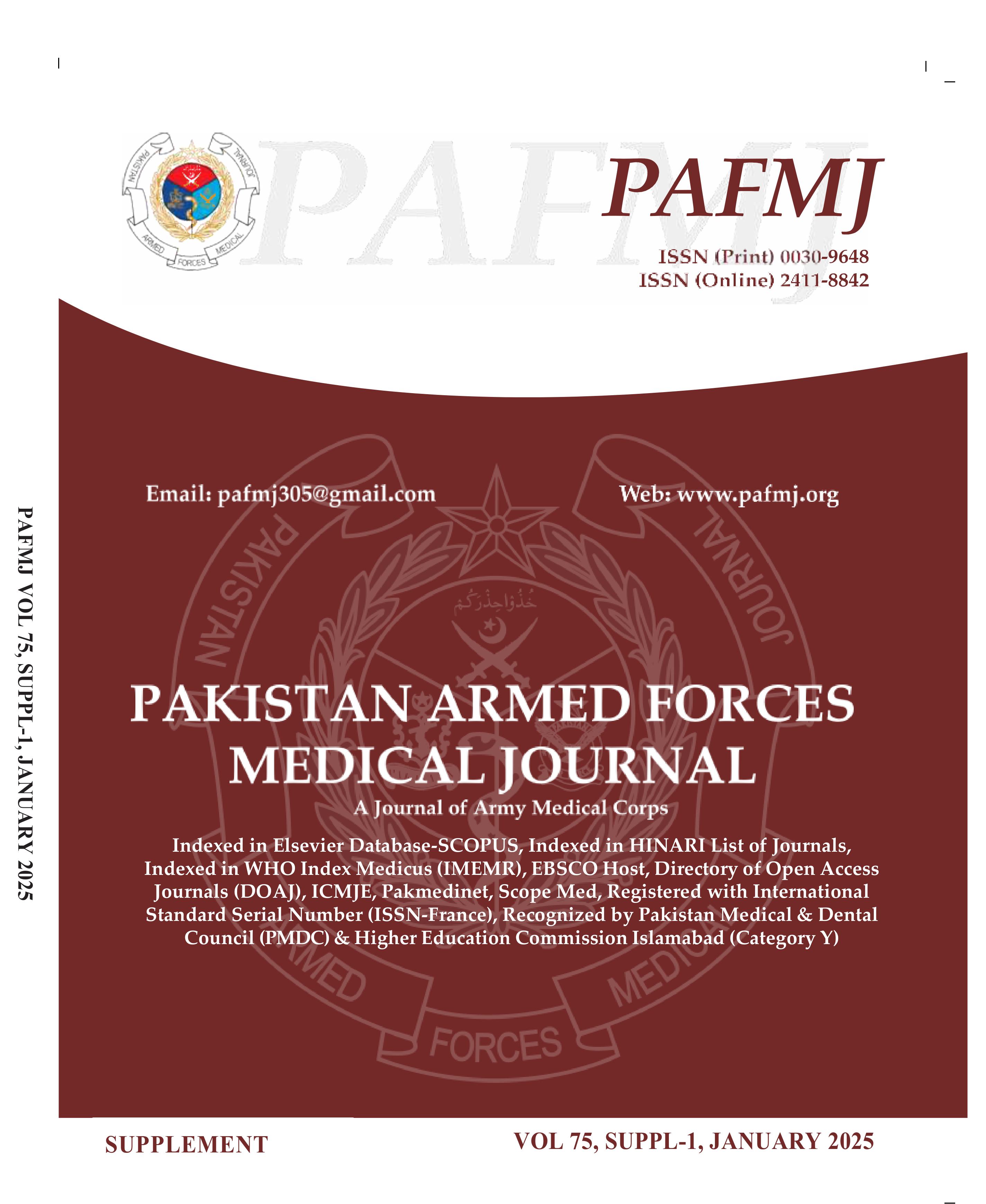Efficacy of Vacuum Assisted Closure Therapy In Healing Diabetic Foot
DOI:
https://doi.org/10.51253/pafmj.v75iSUPPL-1.6331Keywords:
Diabetes, Foot, Negative Pressure Wound Therapy, Vacuum Assisted ClosureAbstract
Objective: To determine the efficacy of vacuum assisted closure therapy compared to conventional therapy in treatment of diabetic foot.
Study design: Prospective comparative study
Place and Duration of Study: Pak Emirates Military Hospital and Combined Military Hospital, Rawalpindi Pakistan, from November 2019 to December 2020.
Methodology: All patients with type II diabetes mellitus aged 45 years and above having Wagner’s classification I or II for diabetic foot were consecutively enrolled into two groups (Group A: vacuum assisted closure technique; Group B: conventional wound management technique). Patients were assessed till 4 weeks. The outcomes were assessed as pain, ulcer size, Wagner’s grade, Granulation score, complete healing, time duration since healing, and debridement requirement.
Results: Of total 60 patients, the median age was 58(54-64) years. There were 21(35%) males and 39(65%) females. The median duration of diabetes was 13(12-15) years. Pain was found significantly lower in group A than that of group B, i.e., 3(0-3) vs. 7 (6-7), p-value <0.001. Similarly, ulcer size was significantly lower in group A as compared to group B, i.e., 12(10-12) vs. 13(13-14), p-value <0.001. However, no significant association of Wagner’s grade (p-value 0.108), granulation score (p-value 0.776), complete healing (p-value 0.573), time duration since healing (p-value 0.633), and debridement requirement (p-value 0.273) was found with respect to group.
Conclusion: The efficacy of vacuum assisted closure was found higher in treatment of diabetic foot compared to conventional therapy.
Downloads
References
Adnan M, Aasim M. Prevalence of type 2 diabetes mellitus in adult population of Pakistan: a meta-analysis of prospective cross-sectional surveys. Ann Glob Health 2020; 86(1): 7.
Ardila IC, Espinosa CM, Vernot PP, Hernández YC, Vaca-González JJ. Clinical-surgical treatment of diabetic foot ulcers in a colombian hospital. Obes Med 2020:100308.
Mavrogenis AF, Megaloikonomos PD, Antoniadou T, Igoumenou VG, Panagopoulos GN, Dimopoulos L, et al. Current concepts for the evaluation and management of diabetic foot ulcers. EFORT Open Rev 2018; 3(9): 513-25.
Selvarajah D, Kar D, Khunti K, Davies MJ, Scott AR, Walker J, et al. Diabetic peripheral neuropathy: advances in diagnosis and strategies for screening and early intervention. Lancet Diabetes Endocrinol 2019; 7(12): 938-48.
Beckman JA, Duncan MS, Damrauer SM, Wells QS, Barnett JV, Wasserman DH, et al. Microvascular Disease, Peripheral Artery Disease, and Amputation. Circulation. 2019; 140(6): 449-58.
Perez-Favila A, Martinez-Fierro ML, Rodriguez-Lazalde JG, Cid-Baez MA, Zamudio-Osuna MJ, Martinez-Blanco MDR, et al. Current Therapeutic Strategies in Diabetic Foot Ulcers. Medicina 2019; 55(11): 714.
Brem H, Sheehan P, Rosenberg HJ, Schneider JS, Boulton AJ. Evidence-based protocol for diabetic foot ulcers. Plast Reconstr Surg 2006; 117(Suppl.7): S193–211.
Hussein AE, Ahmed Hamdy AS, Abd El-Hafez A, El-Aziz A. Outcomes of vac versus conventional dressing in management of diabetic foot ulcer. Al-Azhar Med J 2020; 49(4): 1619-28.
Liu Z, Dumville JC, Hinchliffe RJ, Cullum N, Game F, Stubbs N, et al. Negative pressure wound therapy for treating foot wounds in people with diabetes mellitus. Cochrane Database Syst Rev 2018; 10(10): CD010318.
Cheema SA, Nasir H, Dogar SR, Ahmad UT. Comparison of Vacuum Assisted Closure Technique Versus Conventional Dressing for Management of Wounds in Term of Duration of Wound Healing. Annals Punjab Med Coll 2020; 14(1): 1-4.
Lone AM, Zaroo MI, Laway BA, Pala NA, Bashir SA, Rasool A. Vacuum-assisted closure versus conventional dressings in the management of diabetic foot ulcers: a prospective case–control study. Diab foot ankle. 2014; 5(1): 23345.
James SM, Sureshkumar S, Elamurugan TP, Debasis N, Vijayakumar C, Palanivel C. Comparison of vacuum-assisted closure therapy and conventional dressing on wound healing in patients with diabetic foot ulcer: a randomized controlled trial. Niger J Surg 2019; 25(1): 14.
Dorafshar AH, Franczyk M, Gottlieb LJ, Wroblewski KE, Lohman RF. A prospective randomized trial comparing subatmospheric wound therapy with a sealed gauze dressing and the standard vacuum‑assisted closure device. Ann Plast Surg 2012; 69(1): 79‑84.
Nather A, Chionh SB, Han AY, Chan PP, Nambiar A. Effectiveness of vacuum assisted closure (VAC) therapy in the healing of chronic diabetic foot ulcers. Ann Acad Med Singapore 2010; 39(5): 353 8.
Sajid MT, Mustafa Q, Shaheen N, Hussain SM, Shukr I, Ahmed M. Comparison of negative pressure wound therapy using vacuum-assisted closure with advanced moist wound therapy in the treatment of diabetic foot ulcers. J Coll Physicians Surg Pak 2015; 25(11): 789-93.
McCallon SK, Knight CA, Valiulus JP, Cunningham MW, McCulloch JM, Farinas LP. Vacuum-assisted closure versus saline-moistened gauze in the healing of postoperative diabetic foot wounds. Ostomy/wound Manag 2000; 46(8): 28-32.
Nain PS, Uppal SK, Garg R, Bajaj K, Garg S. Role of negative pressure wound therapy in healing of diabetic foot ulcers. J Surg Tech Case Rep 2011; 3(1): 17‑22.
McCallon SK, Knight CA, Valiulus JP, Cunningham MW, McCulloch JM, Farinas LP, et al. Vacuum‑assisted closure versus saline‑moistened gauze in the healing of postoperative diabetic foot wounds. Ostomy Wound Manag 2000; 46(8): 28‑32.
Blume PA, Walters J, Payne W, Ayala J, Lantis J. Comparison of negative pressure wound therapy using vacuum‑assisted closure with advanced moist wound therapy in the treatment of diabetic foot ulcers: A multicenter randomized controlled trial. Diab Care 2008; 31(4): 631‑6.
Singh B, Sharma D, Jaswal KS. Comparison of negative pressure wound therapy v/s conventional dressings in the management of chronic diabetic foot ulcers in a tertiary care hospital in North India. Int J Sci Res 2017; 6(8): 948 53.
Vaidhya N, Panchal A, Anchalia MM. A new cost effective method of NPWT in diabetic foot wound. Indian J Surg 2015; 77(Suppl 2): 525 9.
Downloads
Published
Issue
Section
License
Copyright (c) 2025 Kamran Khan, Irfan Ali Sheikh, Usman Ghani, Samina Sultana, Tayyaba Mushtaq Khan, Shafqat Noor, Imran Mangi

This work is licensed under a Creative Commons Attribution-NonCommercial 4.0 International License.















